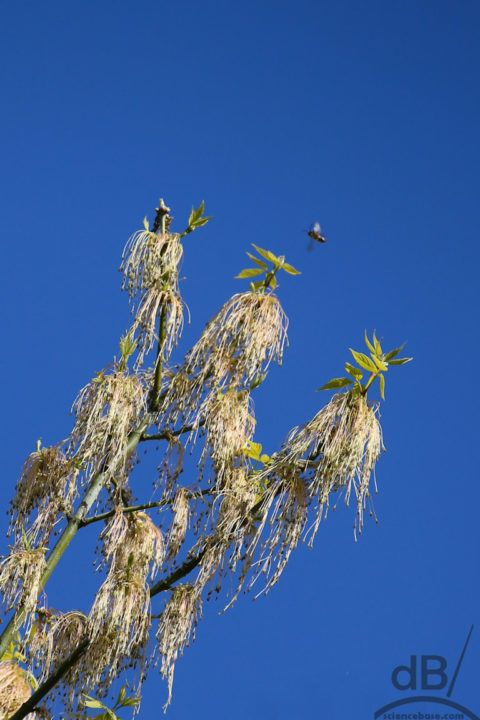A recent late afternoon stroll with Mrs Sciencebase around NT Anglesey Abbey in Lode, near Cambridge, led to a few revelations about various plants and statuaria that were in bloom and uncovered following the winter. There’s an avenue of trees before you leave (not the Winter Walk) but parallel to that with a tree we couldn’t identify. Picture below, tree is about 8-10 metres tall and in this zoomed in shot you can see a bee about to alight on its floral protuberances.

Tall, with both a red and yellow, rhubarb and custard, hue to its aspect overall against the blue of the sky. The curious thing though zooming into the top of the tree, lots of hairy, frond-like flowering “catkins” and shiny bright green leaves that had something of the maple about them but were in clusters rather than growing as separate leaves each on its own stem as one would expect of that family.
The staff on reception were none-the-wiser as to its identity, although one did posit that it was some kind of acer (maple). None of us were convinced and the assistant in the plant sales area didn’t know either, despite his bumper book of tree photographs. I took an email address from reception and sent a message to Philip Hazel. Turns out to be a retired chap with a case of late-onset nominitive determinism of the surname (nevertheless very much worthy of the New Scientist Feedback column to which I contributed back in the day).
Philip identified the tree immediately from my photo. “It’s Acer negundo,“ he told me. “It’s also known as the ‘box elder’, though it isn’t an elder, sometimes it’s called the ‘ash-leaved maple’.” Therein my confusion. An acer called elder that isn’t an elder and has leaves like an ash. Philip, who is a volunteer garden guide at Anglesey Abbey went on to tell me that, “The tree hails from North America and is unusual for a maple in having compound leaves. The flowers, as your photo shows, come in hanging plumes, mostly before the leaves.”
The arboreal weirdness doesn’t stop there. If you pollard (cut back the upper branches to the trunk) of Acer negundo, Philip tells me, it will put up amazing grey spiky shoots, quite unlike an acer . “The discovery of this feature happened after an unwanted self-seeded plant had its top chopped off to stop it growing more,” he tells me. “There are a group of them in the Anglesey Abbey Winter Walk, recently pollarded after the winter season, that looked very ghostly on winter afternoons.” Pictured here.